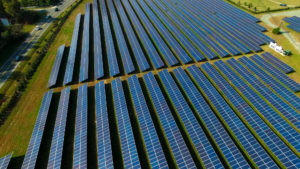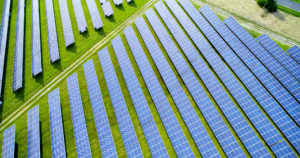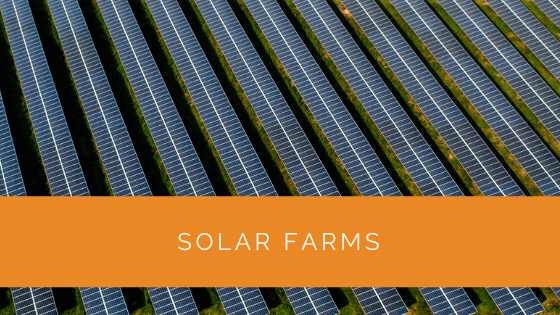As we strive towards a sustainable future, the United Kingdom is taking a proactive approach to combat climate change. In the ever-evolving landscape of sustainable energy solutions, the UK is leading the way by embracing the power of solar farms. These expansive arrays of solar panels have emerged as a critical component of the country’s renewable energy strategy, harnessing sunlight to generate clean, green and cost-effective electricity.
At a time when there is an urgent need to shift away from harmful fossil fuels, solar power offers an exciting and promising alternative. Solar farms are not only environmentally friendly but also economically viable, with the cost of solar energy dropping significantly in recent years. With the promise of long-term sustainability, the UK government is actively supporting the growth of solar farms, providing incentives and subsidies to encourage investment and innovation. In this article, we will delve deeper into the world of solar farms in the UK, exploring their advantages, disadvantages, and the promising future they hold. So, join us on an enlightening journey through the evolving landscape of solar power in the United Kingdom.
Contents
- 1 Key Takeaway
- 2 Evolution of Solar Farms in the UK
- 3 Advantages of Solar Farms
- 4 Disadvantages of Solar Farms
- 5 What Is The Future Of Solar Farms In The UK?
- 6 Top Solar Farms in the UK
- 7 Case Study: Development and Impact of a Solar Farm in the UK
- 8 Expert Insights From Our Solar Panel Installers About Solar Farms in the UK
- 9 Discover the Power of Solar with Solar Panels Network
- 10 Final Thoughts
Key Takeaway
- Solar power is the UK’s third-most used renewable energy source, with a significant increase in usage in recent years, driven by solar panels and solar farms.
- Solar farms in the UK provide clean and locally sourced renewable energy to businesses and households, with approximately 500 solar farms in operation and a substantial growth in capacity since 2014.
- Advantages of solar farms include generating local electricity, minimal maintenance, reducing dependence on non-renewable fossil fuels, and lower environmental impact. In contrast, disadvantages include the need for large land areas and variable energy generation due to changing weather.
Evolution of Solar Farms in the UK
Solar farming has been a prevalent method to harvest sunlight and create solar energy. A solar farm comprises several solar photovoltaic systems that provide renewable energy from different sources.
The land for the solar farm is safe for wildlife and nature. You will also find animals grazing, wildflowers, and grass growth below the solar panels. Solar farms are spread over a large area and are generally located in rural areas.
The process of getting approval for a solar farm is not easy. There have to be proper planning procedures that need to be passed by the government. The site will also be assessed to check if it is suitable for developing the solar farm.
Another essential factor you need to check on is the impact of the farm on the locality. The solar farm should not endanger or harm the locality or environment. It should also be able to fulfil renewable energy needs.
Solar farms can cover between 1 to 100 acres of land. The solar farms should be large enough to power the houses in the area. Approximately 5 megawatts of solar power will power almost 1,500 houses in one year.

Advantages of Solar Farms
Solar farms have been on the increase in the UK, and it is growing continuously every year. Companies are more open to investing in renewable energy sources to power both the commercial and residential sectors. Solar farms have been a great boon for the people of the UK.
Below are some advantages of a solar farm –
- Solar farms help generate local electricity and feed the local grid. The photovoltaic system uses solar power to generate electricity.
- Since solar farms do not have moving parts, maintenance and assembly are not a hassle.
- Solar farms produce renewable energy so that customers can buy green electricity. This reduces their dependence on fossil fuels, which are non-renewable and scarce.
- Solar farms do not generate any waste or by-products. It is only during the dismantling or manufacturing process that it generates any waste material.
- Solar power’s environmental and visual impact is lower than any other energy source.
Disadvantages of Solar Farms
Just like solar farms have their advantages, there are certain disadvantages. The disadvantages of solar farms are as follows –
- Solar farms must use over a thousand panels to power most grids. Hence, solar farms will require several acres of land, which can destroy agriculture and wildlife.
- The energy generation will be limited if the solar power exposure is limited. The climate in the UK is always changing, which could extensively impact solar panels’ efficiency.
- The initial development costs of a solar farm are very high. However, the UK government provides several incentive programs to companies or people favouring solar farms. Even farmers willing to turn their lands into solar farms will get incentives.
- People find solar farms unattractive and a hindrance to the beauty of nature.
What Is The Future Of Solar Farms In The UK?
The UK government has continuously planned to increase solar farms in different localities. One of the largest solar farms in Britain is the Shotwick Solar Park in North Wales.
Another large project in the UK is the Cleve Hill Solar Park, which can power over 91,000 homes. The success of this project would be a positive step towards utilising solar power in the UK.
Even though several changes are taking place regarding solar power, the government has eradicated any subsidies concerning renewable energy projects until 2025. This could impact the number of solar projects initiated in the next few years.
However, the UK government has always been supportive of the development of solar farms. To ensure that the world can move towards a clean and renewable energy source, government support is crucial.
Top Solar Farms in the UK
There are several solar farms in the UK; however, we have mentioned the top five farms here. These are the largest solar farms that are currently operational.
Shotwick Solar Park
One of the largest solar farms in Flintshire, Wales, is the Shotwick Solar Park. This solar farm was collectively developed by Compton Group and We-Link Energy and was commissioned in March 2016.
Shotwick Solar Park generates around 72.2 megawatts of solar energy every year. This solar farm is spread over 250 acres of land.
The solar power produced from this solar farm is used to feed power to private infrastructures. One of the infrastructures is the UPM Shotton Paper Mill, the largest paper mill in the UK. This solar farm supplies 70% of the solar energy used by the paper mill.
Lyneham Solar Farm
The Lyneham Solar Farm is located in Bradenstoke, Wiltshire. It is present on a former runway and is the first solar farm to be developed along with the British Ministry of Defence (MOD).
This solar farm covers around 213.3 acres of land and generates 69.8 megawatts. The solar farm has more than 17 kilometres of interconnected trenches that generate power from about 160,000 solar photovoltaic panels.
The Lyneham Solar Farm and an on-site military training college can provide solar energy to almost 10,000 homes. This solar farm was commissioned in March 2015 and is the second-largest solar farm in the UK.

Owl’s Hatch Solar Park
The next solar farm on the list is Owl’s Hatch Solar Park. This solar park was commissioned in March 2015 and is situated at Herne Bay, Kent. This solar farm can generate about 51.9 megawatts of solar power.
The Owl’s Hatch Solar Park is south of Herne Bay and covers about 212 acres. This solar farm is spread over eight fields.
The solar panels in this solar farm are tilted at an angle of 22 degrees and are 2.4 metres tall. This land is known for its dual use, where the solar farm is located and is also used for agricultural purposes and sheep grazing.
The power generated from this solar farm can be used to feed almost 14,000 homes.
Wroughton Airfield Solar Park
The Wroughton Airfield Solar Park is one of the largest ground-mounted solar farms. This solar farm is a collaborative Science Museum Group and Public Power Solutions (PPS) project.
The Science Museum Group was looking for an income source to help refurbish all the aircraft hangers present on the earlier WWII airfield. This led them to start the solar farm project in collaboration with PPS.
Along with private investors, the 165-acre solar farm project was also funded by the local authorities of Wroughton. This solar farm was finished in March 2016 and could generate 50 megawatts of power and feed 12,000 homes.
West Raynham Solar Farm
The West Raynham Solar Farm was developed in March 2015 and is home to about 200,000 solar panels. This solar farm is spread over 225 acres of land and can generate 49.8 megawatts of solar power.
The solar farm is present in a disused airfield present in Fakenham. The solar energy generated is enough to power 11,000 houses.
Bluefield Solar, a well-known solar energy investor, purchased the solar farmland for £56.5m.
Case Study: Development and Impact of a Solar Farm in the UK
Background
With the increasing focus on sustainable energy, a major renewable energy company decided to invest in developing a large-scale solar farm in the rural outskirts of a UK city. The project aimed to harness solar energy to provide a reliable and eco-friendly power source for local communities and businesses.
Project Overview
The objective was to construct a solar farm capable of generating significant electricity to support local needs. The site chosen was previously underutilised land, deemed ideal for solar panel installation due to its exposure to sunlight and minimal impact on local wildlife.
Implementation
- Site Assessment and Approval: The first step involved a comprehensive site assessment to ensure suitability for a solar farm. Environmental impact assessments were conducted to gauge potential effects on local ecosystems and communities. Upon receiving approval from local authorities, the project moved forward.
- Design and Installation: The design phase focused on maximising energy output by optimising panel layout and orientation. Approximately 20,000 photovoltaic panels were installed, each capable of generating a substantial amount of electricity. The panels were connected to a central inverter system to convert the generated DC electricity to AC for grid distribution.
- Grid Connection and Testing: The solar farm was connected to the local power grid, with extensive testing conducted to ensure efficient operation and safety. This phase also included setting up monitoring systems to track energy production and system performance.
Results
- Energy Production: The solar farm successfully generated an average of 30 megawatts of electricity, enough to power approximately 10,000 homes annually.
- Environmental Impact: The project significantly reduced local carbon emissions by replacing fossil fuel-generated electricity with clean solar energy. The solar farm also contributed to biodiversity by maintaining natural vegetation around the panels, providing a habitat for local wildlife.
- Economic Benefits: The project created jobs during the construction phase and provided long-term maintenance and operational roles. It also supported local businesses by offering them a sustainable energy source, reducing reliance on non-renewable energy.
Summary
The successful implementation of the solar farm not only provided a substantial amount of clean energy but also demonstrated the feasibility and benefits of large-scale solar projects in the UK. The initiative underscored the potential for renewable energy to contribute significantly to the nation’s energy mix, offering both environmental and economic benefits. As solar technology continues to evolve, such projects are crucial in transitioning to a more sustainable future.
Expert Insights From Our Solar Panel Installers About Solar Farms in the UK
Solar farms are a cornerstone of the UK’s renewable energy strategy, offering a sustainable solution to meet growing energy demands while reducing carbon emissions.
Senior Solar Installation Specialist
The scalability of solar farms allows them to supply large amounts of electricity to the grid, supporting both residential and commercial sectors with clean energy.
Renewable Energy Consultant
Despite the initial high costs, the long-term benefits of solar farms, including lower maintenance and the potential for significant energy production, make them a sound investment.
Solar Energy Advisor
Discover the Power of Solar with Solar Panels Network
Are you navigating the world of solar installations? Look no further than Solar Panels Network, the UK’s trusted partner in harnessing the sun’s potential. Our dedication goes beyond just installations; we’re on a mission to transform how homeowners and businesses across the UK perceive and utilise energy. By choosing us, you’re reducing your carbon footprint and making a smart financial move that promises savings for years ahead. Contact us today and embark on your solar journey.
Final Thoughts
The UK has been home to hundreds of solar farms since it understood solar power’s importance. Along with installing solar panels at different houses, the government is pushing the development of solar farms.
With the development of solar farms, several households and commercial properties can be supplied with solar energy. This reduces costs for individual households and provides them with a reliable energy source.
With the development of solar farms, people are reducing their reliance on non-renewable sources like fossil fuels. This has given rise to clean and green energy, which has no adverse effect on the environment.
With more development of solar farms, the UK could become one of the first countries to shift to solar energy and develop an environment-friendly energy source structure.
About the Author
Solar Panels Network stands at the forefront of solar energy solutions, driven by a team of seasoned solar engineers and energy consultants. With over decades of experience in delivering high-quality solar installations and maintenance, we are committed to promoting sustainable energy through customer-centric, tailored solutions. Our articles reflect this commitment, crafted collaboratively by experts to provide accurate, up-to-date insights into solar technology, ensuring our readers are well-informed and empowered in their solar energy decisions.

